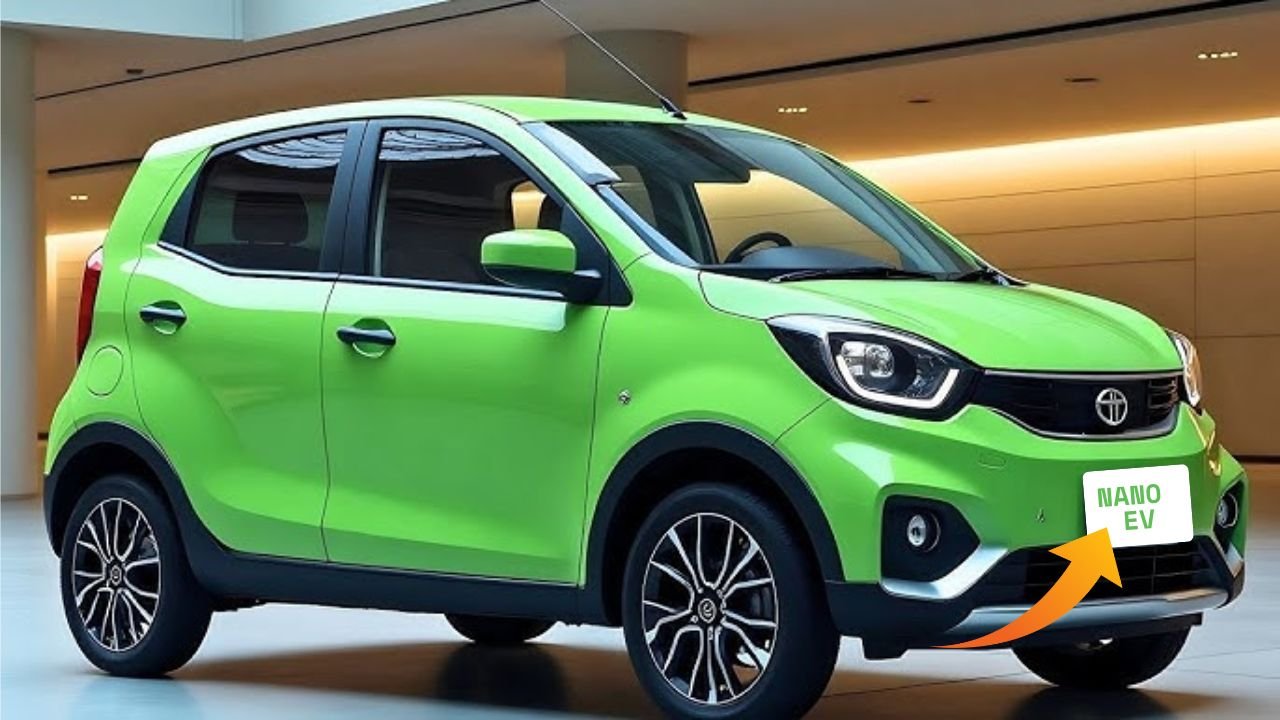Tata Nano EV 2025 Leads Budget EV Wave with Game-Changing Features. In a nation where affordability drives innovation, the Tata Nano EV 2025 marks a landmark moment in the evolution of electric mobility. Touted as the “People’s Electric Car”, this reimagined icon returns not just as a car but as a symbol of accessible technology and urban practicality. As the EV wave sweeps through India with luxury-focused models dominating headlines, Tata Motors flips the narrative with a car that speaks directly to the masses.
Designed to tackle city congestion, pollution, and running costs, the 2025 Nano EV makes a bold statement—electric doesn’t have to mean expensive. And with India’s growing middle class and government focus on sustainable transport, the timing couldn’t be better. The new Nano EV is not just a reincarnation; it’s a bold engineering and social statement, addressing the deepest mobility needs of Indian households.
Let’s dive into what makes this budget EV a game-changer.
Overview Table of Tata Nano EV 2025 At a Glance
| Feature | Specification |
| Battery | 17.3 kWh Lithium-ion pack |
| Range (ARAI Certified) | 250 km per charge |
| Motor Output | 40 hp / 110 Nm torque |
| Top Speed | 80 km/h |
| 0-60 km/h | ~7 seconds |
| Charging Time | 4 hours (AC), 1 hour (Fast DC) |
| Seating Capacity | 4 adults |
| Boot Space | 110 liters |
| Expected Price | ₹4.5 – ₹5.5 lakh (ex-showroom) |
| Launch Timeline | Late 2025 |
Tata Nano’s Genesis & New Design Philosophy
The original Tata Nano debuted in 2008 with the goal of being the world’s most affordable car. While it succeeded in redefining cost-effective manufacturing, it struggled with perception. In 2025, the Nano EV sheds the label of a “cheap car” and emerges as a clever urban EV, leveraging Tata’s EV leadership and the success of models like the Nexon EV and Tiago EV.
The new Nano EV inherits the basic silhouette but now gets a more modern stance, with full-LED headlamps, flush door handles, and aerodynamic tweaks that lower drag. Its monocoque chassis has been updated for battery integration and better crash compliance. Tata has also widened the track and stiffened the suspension to improve ride quality—a previous Nano weakness.
Inside, it’s a world apart: a 7-inch digital infotainment touchscreen, connected car features, auto climate control, and a revamped dashboard bring the Nano into the modern EV era.
Under the Hood: Technical Specs & Performance
Don’t let its compact size fool you—the 2025 Tata Nano EV packs a punchy electric motor delivering 40 horsepower and 110 Nm torque, adequate for the city and short highway runs. It sprints to 60 km/h in under 7 seconds, which feels brisk for a vehicle in this segment.
With a 17.3 kWh battery, the Nano EV offers a certified range of 250 km, ideal for urban commuting and daily errands. Its single-speed transmission ensures smooth, jerk-free driving—perfect for stop-go Indian traffic.
Charging is equally convenient. A standard AC charger tops up the battery in 4 hours, while DC fast-charging takes it from 10% to 80% in just under an hour—game-changing for budget buyers concerned about downtime.
Crucially, Tata has added multi-mode regenerative braking, increasing efficiency and extending driving range, especially during city commutes with frequent braking.
Theory of Design & Boundary Modifications
The design transformation of the Nano EV is rooted in what Tata calls “compressed innovation”. The Nano EV doesn’t just fit within the limitations of a compact form—it redefines them.
Engineers had to work within the boundaries of the original Nano’s compact shell, but made boundary modifications to increase chassis rigidity, improve ground clearance, and allow better underbody airflow for battery cooling. The roofline remains tall to retain headroom, but the EV version is wider and slightly longer to enhance stability.
The interior design now follows a “human-centric minimalism”—smartly packaged, with multi-utility storage, a floating center console, and digital interfaces. Tata also focused heavily on NVH levels, making the cabin surprisingly quiet for its price.
Such attention to design proves the Nano EV is not just a cost-cutting exercise—it’s an example of intelligent engineering under tight design and cost constraints.
Market Differentiation & Business Strategy
Tata Motors is taking a unique route-to-market strategy with the Nano EV. Unlike premium EVs which depend on aspirational marketing, the Nano EV is focused on high volume, low margin profitability. With in-house EV component production, Tata can keep costs down while ensuring quality.
The Nano EV stands virtually alone in the sub-₹6 lakh electric vehicle market, giving it a monopoly in ultra-budget electric urban transport. Tata also plans to leverage its EV subscription model and fleet sales to target shared mobility providers, electric cab operators, and even government procurement programs.
Another strategic move is modular production—the Nano EV shares many components with the Tiago EV, including battery cells, BMS software, and infotainment. This parts commonality helps Tata achieve economies of scale and pass the savings on to customers.
Meeting Indian Conditions: User Needs & Practical Features
The Nano EV has been designed with Indian roads, users, and weather in mind. Its compact size and tight turning radius make it perfect for congested urban areas. High ground clearance, a water-resistant battery pack, and dustproof motor housing make it reliable even in monsoon-prone cities and poorly maintained roads.
Practical features abound:
- Rear parking sensors with camera
- Remote pre-cooling via app
- USB-C fast charging inside
- Two-step rear seat folding for cargo flexibility
The Nano EV also addresses safety—a sore point in the original. It now gets dual airbags, ABS with EBD, and a re-engineered crumple zone, potentially qualifying it for 2- or 3-star Global NCAP rating, impressive for its class.
Challenges and Limitations
Despite its potential, the Nano EV is not without its challenges. One major hurdle is consumer perception—the original Nano’s “cheap car” tag still lingers. Tata will need to rebuild trust with a new narrative focused on technology, sustainability, and urban relevance.
Another limitation is range anxiety. Though 250 km is ample for urban use, it may still fall short for buyers seeking versatility. The small boot space (110 liters) may not satisfy family buyers, limiting the Nano EV to solo and couple usage.
Additionally, India still suffers from limited public EV charging infrastructure in Tier 2 and Tier 3 towns. While Tata Power is rapidly expanding its network, this remains a key area to address for wide adoption.
Social Impact & A Glimpse Into the Future
The Nano EV’s greatest contribution may lie beyond technology—it represents social inclusion in the EV era. It opens doors for middle- and lower-middle-class families to adopt clean mobility, previously limited to affluent buyers.
By enabling mass electric adoption, the Nano EV could drastically reduce urban emissions, noise pollution, and fuel imports. It also supports Atmanirbhar Bharat, as 80% of its components are locally manufactured, fostering EV ecosystem development.
Looking forward, the Nano EV could serve as the platform for new body styles—a cargo variant for last-mile delivery, or even a convertible for urban lifestyle branding. Tata may also release battery-swappable versions or even solar-powered roof add-ons, further enhancing value.
Final Verdict
The Tata Nano EV 2025 is not just a budget electric car; it’s a statement of purpose, built for India’s streets, people, and environmental needs. While it won’t compete with Teslas or BYDs on performance, it’s aiming for something bigger—mass adoption, urban revolution, and democratization of EV technology.
Its game-changing features, from fast charging to urban-focused design, make it a true disruptor. And as India steps into a new decade of green mobility, the Nano EV might just be the most important car on the road—not because it’s fast or flashy, but because it’s finally for everyone.
Also Read
- Yamaha MT-15 V2 vs KTM Duke 200 – Which Reigns Supreme?
- Renault Kwid EV (Electric) Launched with ₹1/Km Cost & Damdar Technology– Check Price!
- Big News! Retirement of Honda CD 110 from the Indian Market? Zero Sales in April 2025!
- Kawasaki Launches a Beast at an Affordable Price with a Powerful 451cc Engine and 30 Km/L Mileage




